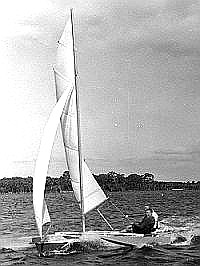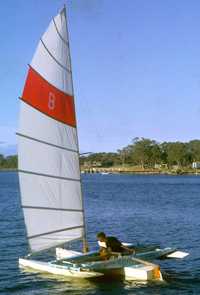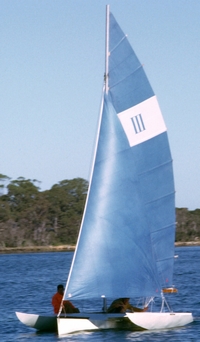 |
 |
 |
 |
 |
 |
 |
 |
 |
 |
 |
 |
 |
 |
 |
 |
 |
 |
 |
 |
 |
 |
 |
 |
 |
 |
 |
 |
 |
 |
 |
 |
 |
 |
 |
 |
 |
 |
 |
 |
 |
 |
 |
 |
 |
 |
 |
 |
 |
 |
 |
 |
|
|
TRIMARANS ON THE GIPPSLAND LAKES |
|
|
|
I have learnt a lot from my friends. Stuart Harris and others taught me about amateur radio. David Theobald and I together learnt saltwater light game-fishing. David Williamson showed me how popular songs were constructed. Lock Crowther taught me a lot about how boats were designed and stimulated my interest in learning more. |
|
|
|
His real name was Lachlan, but he couldn't stand it, and insisted on being called Lock, or Lockie. I knew him slightly from our home town, Bairnsdale. In 1960 or 1961 we ended up by coincidence in the same Melbourne boarding-house. We were both part-time students. As Lockie had a car, he would sometimes give me a ride home to Bairnsdale for the weekend. On one of these weekends home I went to Paynesville, about 15 Km from Bairnsdale, on the Gippsland Lakes. This was one of my favourite places, because of the boats there. There was the Government Slipyard, with its two RAAF crashboats. I loved to peer through the portholes at their triple straight-eight Packard engines. Tied up near the slipyard were rows of fishing boats and cabin cruisers. Between Christmas and New Year there would be speedboat races on the lake. Home-built Bondwood three-pointers powered by modified V-8 car engines would tear around the course at speeds reaching thirty knots and more. |
|
|
|
There were sailing boats at Paynesville too, but they were too slow to attract my interest, until one Saturday afternoon I saw something that moved like a speedboat with sails. From a distance of half a kilometre or so I could see a huge plume of spray arcing out from either side of the boat as it rocketed towards Montague Point in a gust of wind. I wanted to be on that boat. |
|
|
|
 |
|
|
|
|
I knew that Lockie and his family were keen on sailing and that they had built a trimaran. As the sailing speedboat I saw that afternoon was a trimaran, I guessed, correctly, that it belonged to Lockie's family. It was not long before I'd wangled an invitation to go sailing. |
|
|
|
|
|
Their trimaran, 6 metres long, had been designed by Lockie and built out of plywood on wooden frames and stringers by him, his two brothers and their father. Maybe his sister and mother had a hand in it too; they were a close family. The tri was sloop-rigged with a wooden mast. The balanced jib was attached to a boom. The decks between the main hull and the floats were plywood. In an effort to provide lift, the floats were flat-bottomed. Although this feature was not an absolute failure, more often than not it just created extra drag. The trimaran was named Bunyip, after an Australian mythical creature. |
|
|
|
|
|
|
Buyip, Gippsland Lakes, 1960 |
|
|
|
|
|
 |
|
|
|
|
Another feature, intended to prevent broaching, was the very full bow on the main hull. This was the reason for the twin jets of water that came off the forefoot, ensuring that at any speed at all the crew became absolutely saturated. |
|
|
|
|
|
On my first outing, we were three-up; I was just a passsenger. As the wind was fairly light, the Crowthers had rigged a single-luffed spinnaker as a genoa. One of the brothers was out on a trapeze and Lockie was steering. I just sat there, thrilled by the water hosing off the bow into my face, by the rush of wind and by the streaming wake. I was hooked, but I was still a student, with no spare money at all. Building a trimaran myself was out of the question, at least for the time being. |
|
|
|
|
|
Lockie, feeling that he could do better with a new design, started work, in a Melbourne suburban backyard, on a cat-rigged single-hander about 600 mm. shorter than his first effort. The sail was fully battened, with a huge roach. The side-decks were plywood. Instead of a trapeze, there was a sliding seat which could also be pivoted fore and aft. A new idea was the use of a daggerboard in each vee-bottomed float, canted inwards at forty-five degrees so as to provide both lift and lateral resistance. There was also a conventional daggerboard in the main hull. |
|
|
|
|
|
|
Lockie's second design |
|
|
|
|
|
 |
|
|
|
|
This design was not a success. It was too heavy, because of the sliding seat and because it was built out of heavy hardwood plywood instead of the fir plywood which had been to build the earlier design. Being deep in the water, having no jib and with two off-centre daggerboards, the tri would not tack properly. It was almost always necessary to back the main and reverse the rudder to get onto the new tack. |
|
|
|
|
|
Lockie's next attempt was an even bolder step into the unknown. Fortunately, it was much more successful. At that time racing in C-class catamarans for the "Little America's Cup" was all the rage. Lockie decided to design and build a C-class trimaran. The C-class rules required a maximum length of 25 feet (7.6 metres) with a sail area of 300 square feet (28 square metres). At that time his ideas were somewhat influenced by Scandinavian square-metre keelboats, whose main design restriction was also a fixed sail area. They seemed to go well with their large overlapping jib, a genoa, just as Lockie's first design went well in light airs with a genoa. So the new design featured 28 square metres of sail area, about 11 square metres of it in the genoa. This allowed a relatively short aluminium mast, just over nine metres tall, as I recall. |
|
|
|
|
|
|
Trio, my trimaran |
|
|
|
|
|
The main hull was quite different from any of the C-class catamarans. The curved forefoot carried forward into a very fine overhanging curved bow. The mid-section was a conventional (for a multi-hull) semi-circle, but the bottom was flat by the time it reached the transom. The floats had a similar bow, but with a vee-shaped midsection; the afterbody tapered towards a triangular reverse transom. I am not sure where these ideas came from, but they certainly produced an elegant shape. I guess he was trying to minimize wetted surface area and reduce hobbyhorsing. Lockie drew up a nice set of plans for this boat, including an isometric projection I greatly admired |
|
|
|
The three hulls were cold-moulded, with a lot of effort put in by his family, and some by me too, stapling the veneers, then pulling the staples out after the glue dried. (This reminds me of the way ships were built in the days before the steel plates were welded together: half the building crew would be making holes in the plates and the other half filling them up with rivets. Some aircraft are still built this way, although not with steel plate, of course.) |
|
|
|
By now I was earning a proper wage and I wanted to build my own trimaran. For someone who had never made anything more difficult than a doorstop, this was a major decision. I reckoned that I could rely on Lockie and other yachtie friends to advise me on boatbuilding, and save a lot of time by purchasing a ready-made main hull. But who made stock trimaran hulls? No-one, of course; but Charles Cunningham was turning out fibreglass shells for his 6-metre Austral 20 catamaran. I bought one of these, decked it with plywood, built timber-and-ply crossbeams and floats to Lockie's design and fabricated much of the hardware from stainless-steel plate. E.F. Prior of St Kilda made up a genoa and fully battened, heavily roached main out of sky-blue Terylene. The spaces between the hulls were filled with two canvas trampolines, also made by Prior at what my mother considered an exorbitant price. The result was a cut-down version of Lockie's latest creation, with seven percent less sail area, less beam and length and a lot less weight. |
|
|
|
Instead of a daggerboard, I followed Cunningham's idea of using a leeboard. Once we solved the engineering problems -- I broke several boards -- this set-up worked quite well, but obviously was less efficient than a daggerboard. Eventually I discarded the leeboard, glass-and-epoxied a daggerboard case into the hull and made a nice hardwood daggerboard which never looked like breaking. This arrangement proved to be much more efficient. This was the first time I had used epoxy resin. In those days it was very expensive and hard to come by. One of the Bulmer brothers was an industrial chemist and he was able to purchase some for me at a reasonable price. It was as thick as treacle on a winter's day, so I would scoop out each small batch into a pot, heat it on the kitchen stove to bring it to a manageable viscosity, mix it with the right amount of hardener, then apply it very quickly before it started to set. |
|
|
|
Meanwhile, Lockie's larger tri, which he named Kraken, was performing well on the Gippsland Lakes. Admittedly the only competition came from Lightweight Sharpies and Flying Dutchmen, so it was hard to gain a comparison with other similar boats -- C-Class catamarans, for instance. In due course I finished my boat. It should have been up with his, at least in light airs but, partly because of my inexperience, my "Trio" was hardly ever a match for the bigger tri. There was one occasion when Trio beat them all, Kraken included: one of the Gippsland Lakes Yacht Club's annual long-distance races. The course was set from the yacht club at Paynesville, south-west along Lake Victoria to Waddy Point and return, a round-trip of about 15 nautical miles. As there was a gentle south-easterly sea-breeze that day, the course was virtually two long reaches, with no tacking and just a gybe at Waddy Point. We won easily, in record time. |
|
|
|
We also used to cruise the lakes although, without auxilliary power, we ran the risk of being becalmed. Once Hugh Crowther and I took Trio for a day-sail to Lakes Entrance, about 15 nautical miles from Paynesville. We arrived there in good time, had our picnic lunch and headed for home. By the time we got to Metung, only half-way back, it was dark and we had run out of wind. I had to call my father to come and drive us home. We sailed the boat back to Paynesville the following weekend. |
|
|
|
Lockie once took Kraken to compete on Port Phillip Bay. It turned out not to be competitive against large catamarans. They were designed for the bigger seas and stronger winds of the Bay. Our tris excelled in the light breezes and small chop which we mainly encountered on the Gippsland Lakes. |
|
|
|
Neither tri had a spinnaker, but we hardly needed them: our technique was to tack downwind, heading up in the lulls and bearing off in the puffs. Even to windward both tris were faster than all the monohulls, although we would lose out if there was any short tacking to be done. |
|
|
|
Light winds were fun, but it was much more fun when there was a beam reach in a stronger breeze. The sheets would be just started, the apparent wind being well forward of abeam. My crew would be out on a trapeze and so would I, barely maintaining control via the tiller extension, nearly three metres long. |
|
|
|
These good times eventually came to an end. I left for Queensland, returned briefly, sold my boat and went overseas. Lockie decided to give up his day job and move to Sydney where he became a famous and successful designer of trimarans and catamarans. |
|
|
|
Nearly forty years on and living over a thousand kilometres from the sea, I still daydream about boats. These days my interest has returned to powerboats, because I enjoy fishing and need plenty of shade; my skin no longer lets me sit out under the sun for hours. Maybe I can find a design somewhere for an easy-to-build trimaran which could be fitted out with minimal camping-style accommodation and powered by a smallish outboard engine. |
|
|
|
Howard Stephenson |
|
|
|
November 1999 |
|
|
|
Colour photos added July 2005 |
|
|
|
Home |
|





